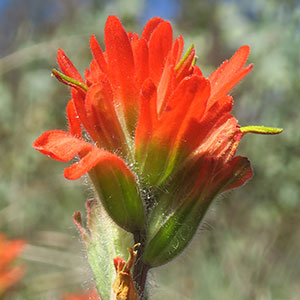Castilleja brevilobata
Castilleja raupii
short-lobed paintbrush
Raup's Indian paintbrush, Raup's paintbrush
solitary or few, erect or ascending, unbranched, sometimes branched, hairs spreading, short, medium, and long, soft, short and medium ones short stipitate-glandular.
few to many, erect to ascending, unbranched or often branched distally, glabrous proximally or hairy, hairs sparse, retrorse, short, ± stiff proximally, distally ± dense, spreading, longer, soft, eglandular throughout.
green or ± yellow, lanceolate, elliptic, or oblong to narrowly ovate, 1–2(–2.5) cm, not fleshy, margins plane or wavy, involute, (0–)3–5(–7)-lobed, apex rounded to acute;
lobes ascending to erect, linear to lanceolate, apex rounded to acute.
purple to green, linear to lanceolate-linear, 2–8(–13) cm, not fleshy, margins plane to slightly wavy, flat or slightly involute, 0-lobed, sometimes 3-lobed distally, immediately below inflorescence, apex narrowly acuminate to acute;
lobes ascending, linear, apex acute.
3–20 × 2–3.5 cm;
bracts proximally greenish to dull brown, distally red, orange-red, or scarlet, sometimes orange or yellow, broadly lanceolate or oblong, (0–)3–5-lobed;
lobes ascending, broadly to narrowly lanceolate, short, arising above mid length, apex acute, obtuse, or rounded.
2.5–12 × 1.5–3.5 cm;
bracts lavender, pink-purple, or reddish purple throughout, sometimes distally white, cream, or pale pink, lanceolate, oblong, broadly elliptic, or ovate, 0–5(–7)-lobed;
lobes spreading to ascending, linear to narrowly lanceolate, short, arising above mid length, central lobe apex acute to obtuse, lateral ones acute.
straight, 15–24(–26) mm;
tube 12–16 mm;
beak exserted, abaxial lip equal to calyx;
beak adaxially green or ± yellow-green, 7–10 mm, puberulent, stipitate-glandular;
abaxial lip deep green, reduced, rounded, 1–2 mm, 10–25% as long as beak;
teeth incurved to erect, light green, 0.5–1 mm.
straight or slightly curved, 15–20(–26) mm;
tube 10–13 mm;
beak and abaxial lip ± exserted;
beak adaxially green, 4–6.5 mm;
abaxial lip purple, magenta, or red, slightly inflated, pouches 3, 2–5 mm, 75–80% as long as beak;
teeth erect, magenta, pink, or red, 1–1.5 mm.
green or whitish with green veins, lobes colored as bract lobes or paler, 14–30 mm;
abaxial and adaxial clefts 5.5–8.5 mm, 30–40% of calyx length, deeper than laterals, lateral 1.5–4 mm, 20–25% of calyx length;
lobes oblong to narrowly triangular, apex obtuse to rounded.
colored as bracts, 13–20(–25) mm;
abaxial and adaxial clefts 6–11 mm, 50–60% of calyx length, deeper than laterals, lateral 0.5–3.5(–7) mm, ca. 25–30% of calyx length;
lobes lanceolate-linear, apex narrowly acute or acuminate.
= 24.
= 72.
Castilleja brevilobata
Castilleja raupii
Castilleja brevilobata is endemic to dry serpentine openings in the Siskiyou Mountains of southwestern Oregon and adjacent California. Although sometimes treated as part of C. applegatei or C. hispida, its morphology does not suggest a close connection with either. This species occasionally hybridizes with C. pruinosa in Del Norte County, California.
(Discussion copyrighted by Flora of North America; reprinted with permission.)
Castilleja raupii is a member of the difficult C. pallida species complex. Castilleja raupii is widespread from southern Alaska to northern Alberta, northwards to the shore of the Arctic Sea, and east to the eastern shore of Hudson Bay. Reports from northeastern Russia are mostly referable to the similar Asian species, C. rubra (Drobow) Rebristaya. Castilleja raupii is sometimes confused with the partially sympatric C. elegans, but C. raupii is a taller plant with often somewhat branched, ascending-erect stems and is often found on more mesic substrates than C. elegans. The inflorescences of C. raupii are usually pink to pink-purple, but more variably colored populations are reported from the delta region of the Mackenzie River in the Northwest Territories of Canada.
(Discussion copyrighted by Flora of North America; reprinted with permission.)


